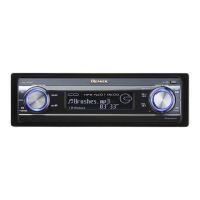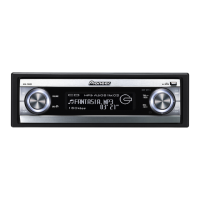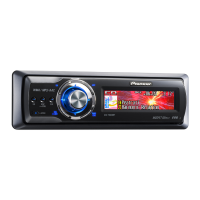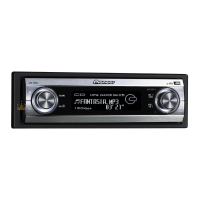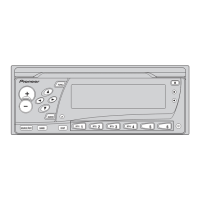Do you have a question about the Pioneer DEH-P880PRS and is the answer not in the manual?
Information for the user regarding equipment operation and modifications.
Details about tuner frequencies and potential reception issues in different areas.
Guidance on how to use the operation manual for optimal enjoyment.
Contact details for after-sales service and warranty information.
Instructions for registering the product online for updates and support.
Overview of supported playback formats: CD, MP3, WMA, AAC, and WAV.
Instructions for detaching the front panel to prevent theft.
Conditions and procedure for resetting the unit's microprocessor.
How to switch between 3-way network and standard modes.
Explanation of the unit's two demonstration modes: reverse and feature demo.
Guidelines for installing batteries and operating the remote control.
Basic steps and indicators for radio operation.
Advanced functions for tuner operation, including BSM and local tuning.
How to store up to six broadcast frequencies for later recall.
Automatic storage of the six strongest broadcast frequencies.
How to view and select stations from the preset channel list.
Using local seek tuning to find stations with good reception.
Basic steps for playing a CD.
How to select a track directly using the remote control.
Advanced operations like repeat play, random order, and scan.
Setting up disc repeat or track repeat playback.
How to play tracks in a random order.
Listening to the first 10 seconds of each track.
Temporarily stopping CD playback.
Switching between fast forward/reverse and 10-track search.
Inputting and displaying CD titles (up to 48 titles).
How to display entered text information for a disc.
How to scroll text information longer than 14 characters.
Viewing and selecting tracks from a CD TEXT disc's title list.
Basic steps for playing various audio file formats.
Direct track selection within the current folder using the remote.
Advanced operations for MP3/WMA/AAC/WAV playback.
Setting up folder, track, or disc repeat for media files.
Listening to the beginning of each track or folder.
Temporarily stopping playback of media files.
Choosing between fast forward/reverse and 10-track search methods.
Displaying text information like folder, file, and artist names.
Scrolling text information that exceeds the display limit.
Viewing and selecting files or folders from a list.
Basic steps for playing a CD with a multi-CD player.
Direct track selection via remote control for multi-CDs.
Information specific to 50-disc multi-CD player models.
Advanced operations for multi-CD players.
Setting M-CD, track, or disc repeat for multi-CD playback.
Playing tracks randomly from multi-CDs.
Listening to the start of tracks or discs in a multi-CD changer.
Temporarily stopping playback of a CD from the multi-CD player.
Creating and using instant track selection playlists.
Deleting individual tracks from an ITS playlist.
Inputting and displaying CD titles for easier disc searching.
How to display entered text information for a disc.
Selecting discs to play using their entered titles.
Viewing text information encoded on CD TEXT discs.
Basic operation for controlling an iPod.
Navigating and selecting songs by category (playlist, artist, album, etc.).
Finding songs by genre, artist, album, or song title.
Choosing and playing songs from an iPod playlist.
Viewing text information recorded on the iPod.
Advanced iPod control features.
Setting repeat play for single songs or all songs.
Playing songs or albums in a random (shuffle) order.
Temporarily stopping iPod playback.
Basic steps for tuning into XM Satellite Radio.
Direct selection of an XM channel by number.
Advanced operations for the XM tuner.
Cycling through different display modes for XM information.
Storing up to six XM broadcast stations for quick recall.
Choosing between channel number and category selection modes.
Navigating and selecting channels within specific categories.
How to display the Radio ID code for specific channels.
Selecting XM stations from a saved preset list.
Basic steps for tuning into SIRIUS Satellite Radio.
Direct selection of a SIRIUS channel by number.
Advanced operations for the SIRIUS tuner.
Changing the information displayed for SIRIUS channels.
Selecting between continuous or one-time text scrolling.
Storing and recalling up to six SIRIUS stations using preset buttons.
Choosing between channel number or category selection for SIRIUS.
Selecting SIRIUS channels by browsing through categories.
Basic steps for operating the TV tuner.
Advanced functions for TV tuning.
Storing up to 12 TV broadcast stations.
Automatically storing the 12 strongest TV stations.
Choosing TV stations from a saved preset list.
Basic steps for playing DVDs or other discs.
Choosing a specific disc from a connected multi-DVD player.
Selecting a folder for MP3/WMA playback on compatible players.
Advanced features for DVD playback.
Setting repeat playback for DVD, Video CD, CD, MP3, or WMA discs.
Temporarily stopping disc playback.
Playing tracks randomly from CD/MP3/WMA discs.
Listening to the first 10 seconds of each track.
Overview of ITS playlist and disc title features for multi-DVD players.
Inputting custom titles for discs (up to 10 characters).
Explanation of 3-way network (NW) and standard (STD) modes.
Symbols used in the manual to denote mode-specific functions.
Detailed audio adjustments available in 3-way network mode.
Detailed audio adjustments available in standard mode.
Simple audio adjustments for both modes using position selector and balance.
Fine-tuning audio settings like time alignment and equalizers.
Overview of the unit's audio adjustment capabilities.
Adjusting audio settings for left/right channels independently or commonly.
Adjusting speaker output levels and delay for optimal sound positioning.
Adjusting left/right speaker balance in 3-way network mode.
Adjusting front/rear and left/right speaker balance in standard mode.
Adjusting speaker distance for precise sound staging.
Customizing time alignment settings for speakers.
How the network function divides audio signals for different speakers.
Overview of adjustable parameters within the network function.
Adjusting the filter attenuation slope for sound continuity.
Switching speaker input signal phase for improved sound continuity.
Muting individual speaker units or filters.
Setting crossover frequencies and levels for network modes.
Turning the subwoofer output on/off and adjusting phase.
Setting cut-off frequency and output level for the subwoofer.
Using high pass filters to prevent low sounds from front/rear speakers.
Adjusting slope and cut-off frequency for front speakers.
Adjusting slope and cut-off frequency for rear speakers.
Applying BBE sound processing for enhanced audio quality.
Adjusting sound quality with BMX reverberation and COMP compression.
Turning the auto-equalizer on or off.
Selecting from seven stored equalizer curves.
Fine-tuning factory-supplied equalizer curves.
Customizing equalizer levels for Custom 1 and Custom 2 curves.
Compensating for low/high sound deficiencies at low volumes.
Adjusting volume levels for different sources to prevent drastic changes.
Automatic adjustment of time alignment and equalization based on car acoustics.
Prerequisites and precautions before performing auto TA and EQ.
Step-by-step guide to perform the auto TA and EQ measurement.
Overview of customizable system settings for optimal performance.
Choosing the preferred language for the unit's display.
Instructions for setting the unit's internal clock.
Option to turn off the warning tone for front panel detachment.
Enabling or disabling the automatic front panel opening for theft protection.
Activating auxiliary inputs (AUX1, AUX2) for external devices.
Automatically dimming the display when headlights are on.
Adjusting the display's brightness level.
Choosing between white and blue illumination colors.
Using digital attenuator to reduce distortion from high recording levels.
How the system mutes or attenuates sound based on external signals.
Turning the internal power amplifier on or off.
Enabling or disabling the feature demonstration mode.
Controlling the screen indication reversal feature.
Setting text information to scroll continuously or once.
Controlling the visibility of the clock display.
Connecting and using external audio devices via AUX inputs.
Choosing AUX as the active audio source.
Customizing the displayed title for AUX sources.
Selecting various visual displays during audio playback.
Operating preprogrammed functions for different sources using the PGM button.
List of CD player error messages, their causes, and suggested actions.
Troubleshooting error messages related to auto TA and EQ functions.
General information and details about audio file formats and disc types.
Guidelines for handling and maintaining CDs for optimal playback.
Precautions and compatibility information for CD-R/CD-RW discs.
Overview of supported audio file formats and their characteristics.
Glossary of technical terms related to audio and file formats.
General specifications including power source, dimensions, and weight.
Detailed specifications for power output, load impedance, and audio processing.
Specifications related to CD playback, including formats and sampling rates.
Technical specifications for the FM tuner.
Technical specifications for the AM tuner.
| Model | DEH-P880PRS |
|---|---|
| Channels | 4 |
| RMS Power Output | 22 watts |
| Peak Power Output | 50 watts |
| Tuner | AM/FM |
| CD Playback | Yes |
| MP3 Playback | Yes |
| WMA Playback | Yes |
| AAC Playback | Yes |
| USB Input | Yes |
| Bluetooth | No |
| Equalizer | Yes |
| DAC | 24-bit |
| AUX Input | Yes |
| iPod Compatibility | Yes |
| Subwoofer Output | Yes |
| Built-in DSP | Yes |
| Time Alignment | Yes |
| DIN Size | 1 DIN |
| Display Type | Organic EL (OEL) |
| Display Colors | Full Color |
| Dimensions (W x H x D) | 178mm x 50mm x 160mm |
| EQ Bands | 13-band |
